Dame Agatha’s Life in Devon
This article first appeared in the book pages of The Ottawa Citizen…since then there have been dozens of films made, books written and visits taken to Agatha Christie’s beloved Greenway. And hopefully, I will be one of their number when we return to Devon next year.
Dame Agatha’s Life in Devon
The year was 1916, and the world was at war. Torquay, a popular resort on the Devon coast in southwest England where Agatha Christie had been born on the 15th of September, 1890, was filled with Belgian refugees, and women of independent means who, like the young Mrs. Christie, were determined to do their bit for the war effort.
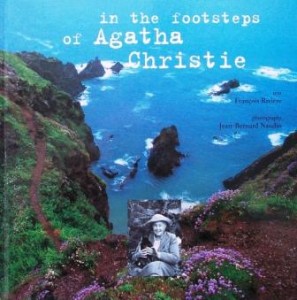
By François Rivière & Jean-Bernard Naudin
The town hall in Torquay had been converted to a Red Cross hospital two years earlier, and Agatha Christie was one of its most dedicated volunteers. She spend thousands of hours nursing wounded soldiers and many more writing letters home on their behalf, until a severe bout of influenza forced her to give up her work on the ward. But several months later, with her new husband, Colonel Archibald Christie away at the front and her mother, Clarissa Miller, holding court at Ashfield, the family home, Agatha was ready for a new challenge.
So she began to write, tentatively at first, and somewhat in the shadow of her older sister, Madge. Madge had already had a number of short stories published in Vanity Fair, and Agatha, an avid reader since childhood, was determined to follow suit, egged on in part by her older sister, who didn’t think she “could do it.” Detective stories were notoriously difficult to write, Madge had warned her, with their complex puzzles and elaborate plots; even she had had trouble concocting one. But Agatha had two things her sister didn’t have: access to a cornucopia of “poisonous substances,” and a driving ambition to succeed.
The hospital dispensary where she now worked had all the tools of the crime novelist’s trade. Vials of arsenic, strychnine, morphine, and belladonna lined the cupboards of the dispensary. All she had to do was learn how to use them. so she studied pharmacy under one of Torquay’s leading apothecaries, a “spooky character” named “Mr. P.” who would show up in one of her later books as the sinister Mr. Zachariah Osborne. But for her first novel she decided to remain on more familiar ground. Her lead characters – a funny little Belgian named Hercule Poirot who was “wonderfully clever, but a bit of a dandy,” and the recently invalided Colonel Hastings, a rather dull but useful “Watson” – were not unlike the people she saw every day on the streets of Torquay, and one of her secondary characters, a young woman named Cynthia Murdoch, even worked in the dispensary at the local Red Cross hospital.
The murder weapon would, of course, be strychnine and the setting classic Christie: English country house, complete with dysfunctional family, hangers-on and faithful servants. Everything had been going well – and the stage was set, the clues planted and the murder committed – until part way thought, Agatha Christie developed writer’s block. She confessed her lack of progress to her mother, and the redoubtable Mrs. Miller took charge. The solution, she determined, was for her daughter to go to a hotel on Dartmoor and stay there until she’d finished.
With its craggy hills of granite known as tors, and its spectacular views of the Devon countryside, Dartmoor National Park was then, as it is now, a wild and desolate place. Sheep roam the park at will. And tourists who hike through the heather on their way to villages with names like Bovey Tracey and Haytor Vale do so at their own risk. Left as it is in its natural state, Dartmoor provides timelessness and a sense of place full of mystery and wonder – just what a burgeoning novelist might need to fuel her imagination.
The haunting beauty of the moors had already proved fertile ground for another writer, Sir Arthur Conan Doyle. He had used Buckfast Abbey, an 800-year-old Benedictine ruin in the middle of Dartmoor National Park, as the inspiration for one of his most famous adventures, The Hound of the Baskervilles, in which Sherlock Holmes solves the mystery of “an evil and luminous demon” roaming the moors by night, and puts an end to the curse of the Baskervilles.
The dramatic countryside must have had a similar effect on Agatha Christie. Two weeks later, she had finished The Mysterious Affair at Styles, and although it wouldn’t be published for another four years, it gave her the impetus she needed to claim writing as her new career. It also cemented her relationship with Dartmoor. “I learned to love the moor in those days,” she wrote in her autobiography. “I loved the tors and the heather and all the wild part of it away from the roads.”
In their beautifully presented book In the Footsteps of Agatha Christie, self-avowed anglophiles François Rivière and Jean-Bernard Naudin lovingly recreate “Agatha Christie’s country” with spectacular photographs, old and new, of the moors, Agatha Christie’s childhood, her years in Torquay and her later years along the River Dart. Originally published in French in 1995, the book was released in English two years later turning the Moorland Hotel into a mecca for Christie fans.
So little had changed since Christie’s 1916 visit, I half-expected to see Poirot and Hastings walking through the gardens to join me on the flagstone terrace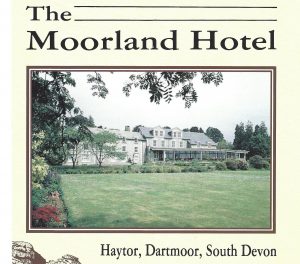 for tea and a generous dollop of Devon Cream. A fire in 1970 had destroyed the hotel’s records so it’s impossible to say which room was Dame Agatha’s, but when I was there in 1997, her portrait still hung in the Agatha Christie Lounge presiding over pre-dinner drinks and lending an air of authority to the proceedings.
for tea and a generous dollop of Devon Cream. A fire in 1970 had destroyed the hotel’s records so it’s impossible to say which room was Dame Agatha’s, but when I was there in 1997, her portrait still hung in the Agatha Christie Lounge presiding over pre-dinner drinks and lending an air of authority to the proceedings.
The hotel has since changed hands and now operates as a popular destination for outdoor holidays, but the legacy of its most famous visitor lives on.
Despite her success, Christie’s was not a charmed life. Her husband Archibald, like many servicemen, had trouble readjusting after the war. He took a job with the air ministry and the young couple moved to London where Dame Agatha continued to write and had her first and only child, Rosalind. After Archie signed on with a friend of his to tour the world as his financial adviser for an upcoming London exposition, an invitation was extended to his wife to travel with them. Never one to turn down an adventure, Dame Agatha readily agreed. The Christies had an incredible trip, visiting South Africa, Australia, New Zealand and Hawaii, where they learned to surf and stayed in a romantic little bungalow amidst the banana trees. Once back in England, however, Archie’s lassitude returned, and an age-old scenario began to play itself out.
He’d taken up golf, a game that held little appeal for his wife – although it had served as a backdrop for her 1923 mystery Murder on the Links. She did go to the club occasionally with her best friend Nan, whose husband was also a member, but most of the time Dame Agatha was in another world, busy planning her next novel or trying to solve a particularly thorny plot problem in the current one. Her mother was ill, she had a young daughter to care for, and Ashfield, her childhood home, was in a state of total disrepair. Archie, meanwhile, had met another woman.
Nancy Neele shared his passion for golf, and they became lovers. When, several months later, Archie finally broke the news to his wife, she up and disappeared. Her car was found the next day, abandoned in a chalk-pit on the Surrey Downs. Several hundred police and countless volunteers scoured the countryside. Ten days later, Agatha Christie was discovered in a hotel in northern England, registered under the name of Mrs. Neele. When pressed, she claimed to have had amnesia. Despite Fleet Street’s unceasing speculation, Dame Agatha never publicly explained her disappearance.
Robert Barnard, author of a biography entitled A Talent to Deceive, wrote, ‘This refusal to give herself away publicly…is one of her great strengths as a writer…Each of her characters is surveyed, analyzed, dissected as murderer-potential, without an ounce of involvement,” except for maybe Hercule Poirot who might perhaps arouse a “flicker of irritation” in his creator.
And so Hercule Poirot, the little Belgian with the fastidious moustache who had the familiarity of the French and the exotic appeal of a foreigner, went on to wow the world, as did Miss jane Marple, and to a lesser extent, Christie’s other series characters, Tommy and Tuppence, although they are about to return to the limelight
Along the way, Agatha Christie also wrote six romances under the pseudonym Mary Westmacott in the style of a favourite author of her youth, May Sinclair. Despite the many plays and screen adaptations of Christie’s work, including Witness for the Prosecution and Murder on the Orient Express, one of her biggest coups was a play she wrote in 1952. The Mousetrap has since become the world’s longest-running stage play, and the source of endless royalties, all of which she left to her grandson, Matthew.
Whether you’re looking for mystery or an opportunity to explore Christie’s natural habitat, travelling through Devon with In the Footsteps of Agatha Christie as reference will take you from her museum in Torquay across the moors to Haytor and the Moorland Hotel, and then on to the River Dart where Dame Agatha spent a large part of her life with her second husband, archeologist Max Mallowan. They’d met in 1928 on an excavation site in Baghdad and married two years later. For the rest of their married lives, they would divide their time between London, the Middle East and Devon. While her husband wrote archeological tomes, his wife continued her crime writing, rarely granting interviews and steadfastly guarding her family’s privacy, particularly when they stayed at Greenway House, the home she’d purchased overlooking the Dart in 1938.
In all, Agatha Christie wrote 15 novels set in, or around, Devon County. And while innumerable books analyze her work, In the Footsteps of Agatha Christie clearly celebrates her years in Devon. The last third of the book is a village-by-village tour of her most famous haunts, complete with recommended walking tours, travel directions and even suggestions for where to get a good pub lunch.
So if what you’re after is a sense of what helped create Agatha Christie’s life as a crime writer, this is the year to visit Devon. But be warned: by the time you finish, you’ll want to download, or dust off, your favourite Agatha Christie. Or search out David Suchet’s art deco interpretation of the classic Christie detective, Hercule Poirot, who was brought to life on Dartmoor and raised on Devon Cream.
The Boy She Left Behind
The choice was hers. To follow her dream or stay home and live his.
THE BOY SHE LEFT BEHIND
Last spring Susan and I were asked by Seattle-based author Sierra Hill if we’d like to be part of The All-American Boy Series.
Fifteen stand-alone romances from fifteen best-selling authors all set in the fictional town of Merlot, California. It was a perfect fit for us. And a chance to explore the new adult market which has become increasingly popular in the last few years,. We knew right away we wanted to write a “second-chance” love story…
But this time we’d be writing in the first person point-of-view, starting with Zoe….
THE BOY SHE LEFT BEHIND
 The second I saw Brock Jamieson, I knew I was in trouble.
The second I saw Brock Jamieson, I knew I was in trouble.
The boy I’d left behind four years ago had become a man, rugged, handsome and oozing sex appeal. My mouth watered, but we weren’t high-school sweethearts anymore. And I’d be damned if I’d fall for him again.
My plan was to stay in Merlot for the summer, then head back to the big city and pursue my career. Unlike Brock, I wasn’t heir-apparent to a family winery. I’d fought hard to get into art school.
But none of that mattered to him. He wanted me, Zoe French, back in his arms and back in his life – and this time he was playing for keeps.
It’s ladies first in THE BOY SHE LEFT BEHIND, but every second chapter goes to Brock, and Zoe was right — Brock Jamieson is definitely worth a second look!
THE BOY SHE LEFT BEHIND is now available on: Kindle
A Sense of Place…
From a long-ago visit to Meadowbrook Hall to a new Amber & Elliot Mystery!
I recently sent three of my children’s books to relatives in Texas. They have grandchildren living nearby, and others in Michigan, who are just the right age for the stories I write. And while I do write for adults as well, capturing that “sense of place” is key. The world in which your characters live and breathe gives their story, and yours, the veracity it needs to draw the reader into the world you have created.
Having grown up around the Great Lakes — my family had a cottage on Lake Huron for 30 years — most of my books for young readers are set in small-town Ontario. Or, in the the case of the Amber & Elliot Mysteries, which I co-author with long-time friend Susan Brown, an unidentified location that works on both sides of the border.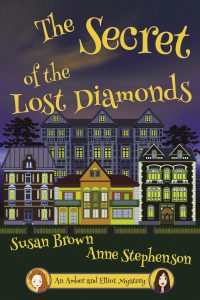
And we have just released our third Amber & Elliot which was inspired by a stay at Meadowbrook Hall in the mid-1980s. As presenters at the Detroit Women Writers’ conference (held at Oakland University), we were “billeted” in the bedroom that once belonged to Frances Dodge, daughter of automotive tycoon John F. Dodge.
It was awesome! Beautifully furnished, with four-poster beds, richly upholstered chairs, and leaded glass windows overlooking the garden. We spent two nights at Meadowbrook Hall, discreetly exploring its secrets, and tucking them away for a future novel. Little did we know how long it would be before we had the time, and opportunity, to tell our story.
The Secret of the Lost Diamonds
In a last-ditch effort to save his family home, Henry Hamilton agrees to host a writers’ conference at Ash Manor. On one condition — he wants super sleuths Amber Mitchell and Liz Elliot to find the famous Hamilton diamonds before it’s too late!
The stakes are high from the moment they walk in the door. With mystery writers looking for the perfect plot, and their friends Craig and Jonathan skulking in the shadows, Amber & Elliot take to the secret passageways in search of the precious jewels…
“Where are we?” Amber whispered.
“We must be in the family wing,” Liz said softly.
The girls stared at the old-fashioned furnishings: paintings in gilt frames, a pair of plush sofas, and two leather wing chairs facing a fireplace.
“I bet no one’s been in here for years,” breathed Amber, taking a step forward.
Suddenly Liz choked out a scream. Amber clutched her throat. They watched in horror as a hand slowly reached out from behind the chair…
To find out what happens next in The Secret of the Lost Diamonds visit Amazon, Kobo & Apple
The Amber & Elliot Mysteries 
The Mad Hacker on Amazon, Kobo & Apple
Something’s Fishy at Ash Lake on Amazon, Kobo & Apple
The Secret of the Lost Diamonds on Amazon, Kobo & Apple
What’s in a name…?
When I wrote the following article, in late 2017, Susan and I had already reissued Something’s Fishy at Ash Lake for a new generation of young readers, but The Mad Hacker, book one in the series, remained out-of-print, patiently waiting for an update and a new cover….
And here it is — the first Amber & Elliot Mystery — as well as my 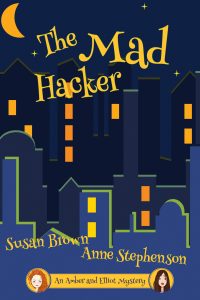 original post.
original post.
How we almost hit the big time & lived to tell the tale!
When Susan Brown and I decided to adapt The Mad Hacker, our first co-authored book, for television, we realized we would have to come with a name that was perhaps a little less indicative of an axe murderer, and more in keeping with a pair of adventurous twelve-year-olds.
Amber Mitchell and Liz Elliot had been best friends forever and were, shall we say, chips off their creators’ old blocks…
The plotline revolved around the sabotage of their grade-seven computer projects. Rather progressive, we thought (and still do) given that we wrote the first chapter of The Mad Hacker in 1985 using typewriters. Neither of us actually owned a personal computer at the time. Our kids were in primary school; they had the access and we had the story.
Several years later…The Mad Hacker had sold over 75,000 copies in book form in Canada, New Zealand and Australia, Something’s Fishy at Ash Lake, our second book featuring the girls and their friends at Ash Grove Junior High, had by then been sold to Scholastic Canada, and negotiations were underway with a Toronto production company.
We decided it was time to “rebrand” the series. Scholastic had billed the first two books as Ash Grove High Mysteries, but we 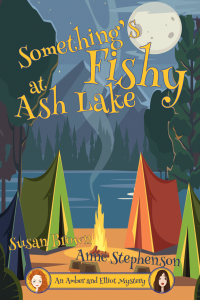 wanted something new and a little less cumbersome. So we culled our collective memories as well as the current TV pages, listing show titles that worked, especially mysteries, right back to the early days of television.
wanted something new and a little less cumbersome. So we culled our collective memories as well as the current TV pages, listing show titles that worked, especially mysteries, right back to the early days of television.
Nine times out of 10, the most successful series had titles which were either situation-specific or simply used the main character, or characters’ names, to sell the show.
Our characters weren’t that well-known, but they were memorable, especially when they played off each other like that other famous pair of detectives: Dr. Watson and Sherlock Holmes. After all, Amber had been heard to address Liz as “my dear Elliot” more than once in both books.
So, Amber & Elliot, it became.
We liked the cadence. We liked the way Liz’s surname gave the team more weight. But most of all we liked the fact that it didn’t sound, as “Amber and Liz” would have, like two little girls going to a birthday party.
Amber & Elliot may not have made it to the big time (the pilot aired on The Family Channel and CTV), but we felt like we did – if only for a short time. And, among many lessons learned, we came to appreciate just how important titles (and hanging onto your rights) can be!
The Amber & Elliot Mysteries
The Mad Hacker on Amazon, Kobo & iBooks
Something’s Fishy at Ash Lake on Amazon, Kobo & iBooks
And coming soon, our third Amber & Elliot Mystery: The Secret of the Lost Diamonds!
